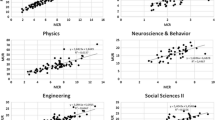Abstract
It is the objective of this article to examine in which aspects journal usage data differ from citation data. This comparison is conducted both at journal level and on a paper by paper basis. At journal level, we define a so-called usage impact factor and a usage half-life in analogy to the corresponding Thomson’s citation indicators. The usage data were provided from Science Direct, subject category “oncology”. Citation indicators were obtained from JCR, article citations were retrieved from SCI and Scopus. Our study shows that downloads and citations have different obsolescence patterns. While the average cited half-life was 5.6 years, we computed a mean usage half-life of 1.7 years for the year 2006. We identified a strong correlation between the citation frequencies and the number of downloads for our journal sample. The relationship was lower when performing the analysis on a paper by paper basis because of existing variances in the citation-download-ratio among articles. Also the correlation between the usage impact factor and Thomson’s journal impact factor was “only” moderate because of different obsolescence patterns between downloads and citations.








Similar content being viewed by others
References
Armbruster, C. (2007). Access, usage and citation metrics: What function for digital libraries and repositories in research evaluation? Online available at URL: http://www.lub.lu.se/fileadmin/user_upload/pdf/NCSC/ncsc2008_chris_armbruster.pdf (26 November 2008).
Bollen, J., & Van De Sompel, H. (2008). Usage impact factor: the effects of sample characteristics on usage-based impact metrics. Journal of the American Society for Information Science and Technology, 59(1), 136–149.
Bollen, J., Van De Sompel, H., Smith, J.A., & Luce, R. (2005). Toward alternative metrics of journal impact: A comparison of download and citation data, online available at URL: http://public.lanl.gov/herbertv/papers/ipm05jb-final.pdf (26 November 2008).
Brody, T., Harnad, S., & Carr, L. (2006). Earlier web usage statistics as predictors of later citation impact. Journal of the American Society for Information Science and Technology, 57(8), 1060–1072.
Chu, H., & Krichel, T. (2007). Downloads vs. citations in economics: Relationships, contributing factors & beyond. In: Proceedings of the 11th International Society for Scientometrics and Informetrics conference, pp. 207–215, Madrid, Spain, June 25–27.
Darmoni, S. J., Roussel, F., Benichou, J., Thirion, B., & Pinhas, N. (2002). Reading factor: a new bibliometric criterion for managing digital libraries. Journal of the Medical Library Association, 90(3), 323–327.
Duy, J., & Vaughan, L. (2006). Can electronic journal usage data replace citation data as a measure of journal use? An empirical examination. The Journal of Academic Librarianship, 32(5), 512–517.
Gorraiz, J., & Schloegl, C. (2008). A bibliometric analysis of pharmacology and pharmacy journals: Scopus versus Web of Science. Journal of Information Science, 34(5), 715–725.
Kurtz, M. J., Eichhorn, G., Accomazzi, A., Grant, C., Demleitner, M., Murray, S. S., et al. (2005). The bibliometric properties of article readership information. Journal of the American Society for Information Science and Technology, 56(2), 111–128.
Mcdonald, J. D. (2007). Understanding journal usage: A statistical analysis of citation and use. Journal of the American Society for Information Science and Technology, 58(1), 39–50.
Moed, H. F. (2005). Statistical relationships between downloads and citations at the level of individual documents within a single journal. Journal of the American Society for Information Science and Technology, 56(10), 1088–1097.
Rowlands, I., & Nicholas, D. (2007). The missing link: Journal usage metrics. Aslib Proceedings, 59(3), 222–228.
Wan, J.-K., Hua, P.-H., Rousseau, R., & Sun, X.-K. (2008). The download immediacy index (DII): Experiences using the CNKI full-text database (in press).
Acknowledgements
The authors would like to thank Mr. Niels Weertman from Science Direct for providing the necessary usage data.
Author information
Authors and Affiliations
Corresponding author
Appendix
Appendix
Rights and permissions
About this article
Cite this article
Schloegl, C., Gorraiz, J. Comparison of citation and usage indicators: the case of oncology journals. Scientometrics 82, 567–580 (2010). https://doi.org/10.1007/s11192-010-0172-1
Received:
Published:
Issue Date:
DOI: https://doi.org/10.1007/s11192-010-0172-1




